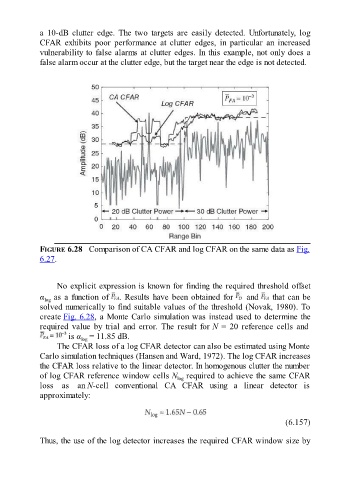Page 522 - Fundamentals of Radar Signal Processing
P. 522
a 10-dB clutter edge. The two targets are easily detected. Unfortunately, log
CFAR exhibits poor performance at clutter edges, in particular an increased
vulnerability to false alarms at clutter edges. In this example, not only does a
false alarm occur at the clutter edge, but the target near the edge is not detected.
FIGURE 6.28 Comparison of CA CFAR and log CFAR on the same data as Fig.
6.27.
No explicit expression is known for finding the required threshold offset
α as a function of . Results have been obtained for and that can be
log
solved numerically to find suitable values of the threshold (Novak, 1980). To
create Fig. 6.28, a Monte Carlo simulation was instead used to determine the
required value by trial and error. The result for N = 20 reference cells and
is α = 11.85 dB.
log
The CFAR loss of a log CFAR detector can also be estimated using Monte
Carlo simulation techniques (Hansen and Ward, 1972). The log CFAR increases
the CFAR loss relative to the linear detector. In homogenous clutter the number
of log CFAR reference window cells N required to achieve the same CFAR
log
loss as an N-cell conventional CA CFAR using a linear detector is
approximately:
(6.157)
Thus, the use of the log detector increases the required CFAR window size by

